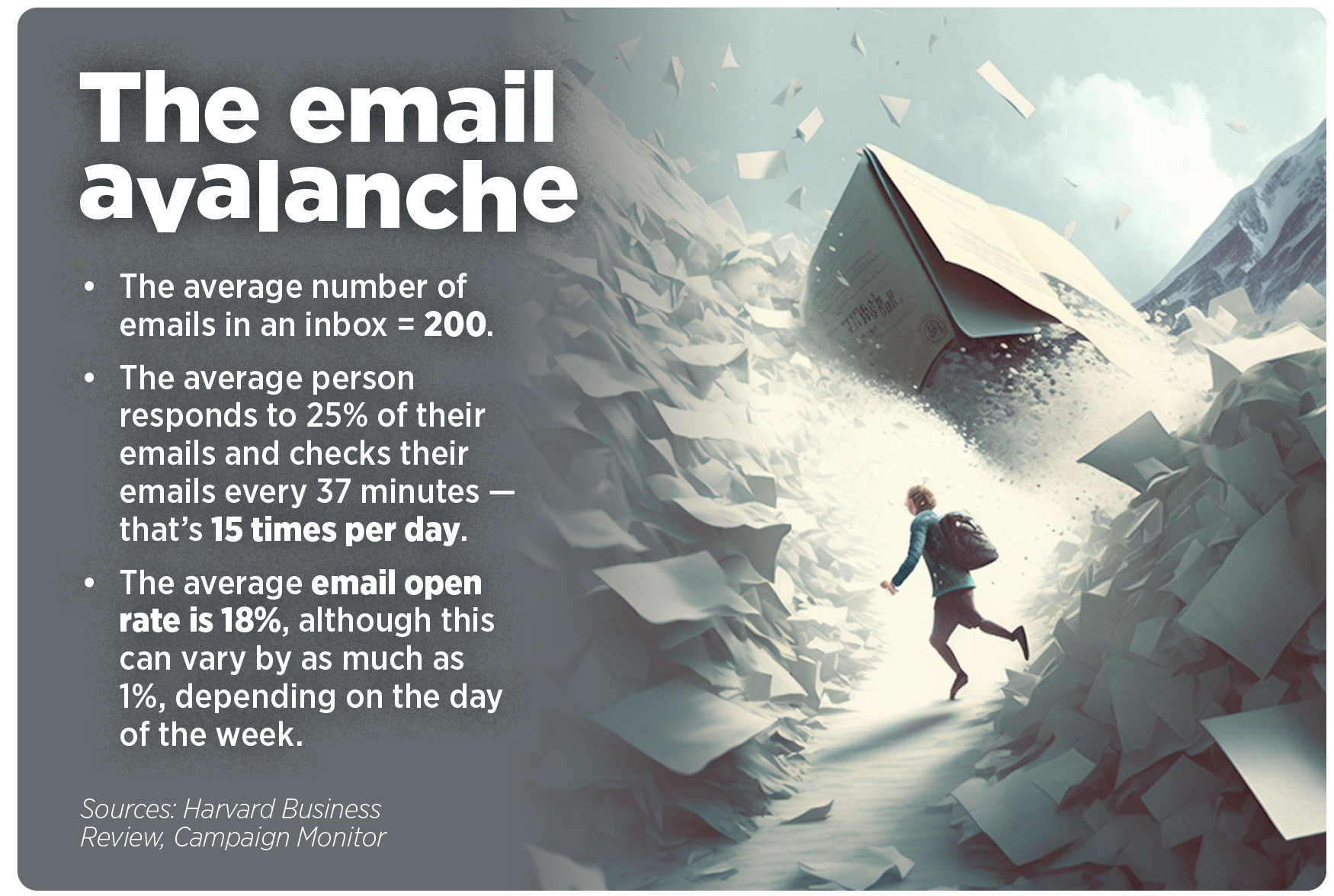Keep your emails out of the spam folder

If it seems as though your email inbox is getting bigger every day, you’re not mistaken.
The number of emails sent and received keeps increasing each year and is expected to reach 347.3 billion in 2023. That’s an increase of 4.3% from last year, according to Oberlo, an online shopping platform.
Email marketing can be effective, with every dollar spent on email generating an average return on investment of about $42, Campaign Monitor reports. But email also can be a source of frustration. The average businessperson receives 120 emails a day, and 55% of them are spam, Oberlo said. In addition, email can be a time suck. The average professional responds to only 25% of emails in their inbox.
Furthermore, professionals check their emails an average of every 37 minutes — that’s 15 times per day — but open only about 18% of the messages they receive.
Observing email etiquette and crafting your message carefully can keep you from becoming an email “stalker” and can help keep your message out of the spam folder, two business etiquette experts told InsuranceNewsNet.
Rachana Adyanthaya is a business etiquette and image consultant and founder of cr8mychange.com, where she advises on career enhancement and etiquette. Julia Esteve Boyd is an international etiquette consultant and author of A Dash of Decorum. The two women host the Manners Matter podcast.
Email messaging can be quick and informal, but an email message in a professional setting must be crafted carefully, Adyanthaya said.
“Some of the obvious and common mistakes I see with email are not including a subject line and not presenting yourself in the way that you should be in a business setting,” she said. “I believe email has become so sloppy, and it shouldn’t be.”
Email messages must be concise and to the point, but they also need to contain some level of familiarity, she added. “You need to get the tone right. If your email contains more than just a paragraph, it often won’t get read. So you must be concise, include a greeting, put a call to action at the end and sign off. That all shows professionalism.”
Adyanthaya said grammar and spelling errors in an email will brand you as unprofessional, and many of those mistakes are made when dashing off a quick message.
“Check your grammar, take some time to check your email after you’ve crafted it,” she said.
“You can use an app such as Grammarly if you’re not sure about your grammar skills, and make sure you use spell check.”
The goal for a business email, Adyanthaya said, “is to provide an eloquent and put-together message.”
When emails are sent to multiple people and the recipients respond by replying to all,” that can cause confusion, she said.
“If you have a particular subject heading and people respond by adding extra points or adding points that aren’t relevant to the subject, the resulting email trail can become confusing and lead to people not reading it at all.”
Another potential pitfall of “replying to all” is that the email recipients can sometimes become emotional or even argumentative when replying to the group. It’s important to watch your reply tone and keep your emotions in check when replying, Boyd said.
“One suggestion when you are having a difficult time keeping from being emotional in your response is to respond directly to one person instead of to everyone on the email list,” she said.
Not everyone who is in the list of email recipients needs to be in the entire email chain, she added. “There may come a point where all of them don’t need to be involved in the conversation, and if you hit reply all, you’re only increasing the clutter people have in their inboxes. So be a little bit cautious with using reply all and do it only if it is relevant and important.”
It also might be tempting to tackle a lot of different talking points in a single email, but that can lead to confusion as well, Adyanthaya said.
“In a situation like that, it’s better to stick to one subject and then send out a different email with a different subject instead of including several different topics in one message. You are more likely to come across in a professional manner, and your email recipients are more likely to pay attention to the topic at hand.”
Don’t try to oversell
When sending an email to a prospect, Boyd advised being courteous and formal, piquing the prospect’s interest without trying to oversell.
“You want to tell a potential client who you are and what you offer without a hard sell,” she said. “Clarity in the email is important as well. Be concise. Use the word ‘you’ more than you use the word ‘I.’”
Customizing your message to different prospects also is important, Boyd said. “Instead of sending a standardized message to anyone and everyone, create a message for different types of prospects, and word that message in the way that’s right for each prospect type.”
Drip, drip, drip
The key to a successful email drip marketing campaign is to have a different subject line with each consecutive email and to feed the recipient a tiny bit of information that leads to a call to action to learn more, Adyanthaya said.
“Don’t send a lengthy email right off the bat, and don’t keep repeating what you already said in the last email,” she said. “Know your target market and be really clear about what you are trying to sell them. Keep the subject lines interesting and don’t send the same subject lines out more than once.
“It’s about building a relationship, building that trust, being very clear with your message.”
Adyanthaya suggested a strong beginning, a few bullet points and a compelling call to action at the end.
“I think people tend to read the beginning of a message, lose interest somewhere in the middle part of it and then see what is the point at the end of the message. So your message needs to follow that structure.”
Stay off the naughty list
The quickest way to end up on someone’s “do not email list” is to be annoying, Boyd said.
“If you don’t want someone to block you, don’t be annoying,” she said. “Don’t send repeated emails, don’t ask too many questions. When you send an initial email, take your time before you follow up with another one.
If you followed up once or perhaps twice and didn’t get any input or feedback, then it’s time to back off. You still have the opportunity in the future to reach out again. A few months down the line, you can email again and say, ‘I reached out to you a few months ago,’ and now maybe this is the time to start a conversation.”
As for the prospect who isn’t a good fit and isn’t responding to email, Boyd suggested simply moving on.
“I will politely decline something once, and if you answer me after that, I usually I just don’t respond because you can’t respond to every email,” she said. “If I look at the subject line and see this isn’t something that I’m looking for, I will delete the message without opening it. This is why your subject line must be appropriate and relevant.
“If I have declined in a nice way and someone follows up, I don’t respond any further. Otherwise, they’ll be sending me multiple emails, and we don’t have time for this. We all have other important things to do.”
Susan Rupe is managing editor for InsuranceNewsNet. She formerly served as communications director for an insurance agents' association and was an award-winning newspaper reporter and editor. Contact her at [email protected].






It’s go time for financial advisors on social media
A month to consider women’s history — and why change is needed
Advisor News
- Bill that could expand access to annuities headed to the House
- Private equity, crypto and the risks retirees can’t ignore
- Will Trump accounts lead to a financial boon? Experts differ on impact
- Helping clients up the impact of their charitable giving with a DAF
- 3 tax planning strategies under One Big Beautiful Bill
More Advisor NewsAnnuity News
- An Application for the Trademark “EMPOWER INVESTMENTS” Has Been Filed by Great-West Life & Annuity Insurance Company: Great-West Life & Annuity Insurance Company
- Bill that could expand access to annuities headed to the House
- LTC annuities and minimizing opportunity cost
- Venerable Announces Head of Flow Reinsurance
- 3 tax planning strategies under One Big Beautiful Bill
More Annuity NewsHealth/Employee Benefits News
Life Insurance News
- On the Move: Dec. 4, 2025
- Judge approves PHL Variable plan; could reduce benefits by up to $4.1B
- Seritage Growth Properties Makes $20 Million Loan Prepayment
- AM Best Revises Outlooks to Negative for Kansas City Life Insurance Company; Downgrades Credit Ratings of Grange Life Insurance Company; Revises Issuer Credit Rating Outlook to Negative for Old American Insurance Company
- AM Best Affirms Credit Ratings of Bao Minh Insurance Corporation
More Life Insurance News